barbs09
Hazard to Others
  
Posts: 113
Registered: 22-1-2009
Location: Australia
Member Is Offline
Mood: No Mood
|
|
Dung bitumen
Greetings, I work in the outback of Australia as an exploration geologist and see a few interesting things in the course of my work.
One observation that I think is interesting and likely a biochemical oddity is the presence of a black, bituminous, hard often lustrous material that
occurs on the roofs of shallow caves that occur in weathering granite escarpments that we locally call "break-aways". The material has a sharp
tarry-like "animal" smell, not unlike under the grated floor of a woolshed (sheep), but different…
There is not a lot written on this material (I can find), but it has been called "dung bitumen" or "psedubitumen". It likely forms as a result of
water percolating through bat and other animal dung and due to dry conditions accumulates as a solid mass over time rather than washing away (sort of
dung flavoured stalactites).
The substance is discussed in a few old West Australian Mining reports with a 1905 Western Australia Department of Mines report presenting a single
chemical analysis (see attached). Briefly it contained 44% organics and was quite soluble in water. It quotes a lowish nitrogen percent, but I think
this of the residue left after a LOI. The high Fe and SiO2 likely associated with the Fe-rich country rock. This report is downloadable below:
http://www.dmp.wa.gov.au/Documents/About-Us-Careers/AnnualRe...
Some of the compounds it may contain include: oxalates ammonium oxalate and calcium oxalate (mineral names; oximite and weddalite respectively), uric
acid (mineral name: uricite) and guanine. see pp 123 in: https://library.dbca.wa.gov.au/static/FullTextFiles/071896.p...
Reading around it may also contain nitrates, phosphates, silica...
I have collected some and plan to carry out a few basic tests: I can report the following:
• It is reasonably soluble, though had to head back to work before I could see what type of crystals form (very dark brown clear liquid)
• It did not burn/melt
• Paper soaked in the solution and dried did not act like it contained nitrate when touch with flame.
Ran out of time to try other tests, though I presently have minimal reagents or glassware.
Need to research tests for guanine. Guessing a precipatate with solule iron compound will test for oxalates.
I am not presuming that this a great source of any particular reagent, but I’m able to collect a fair amount, so you never know…
Anyone else living in arid regions seen anything like this or have any other ideas what it might contain?
Cheers
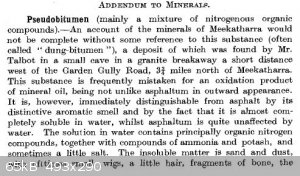 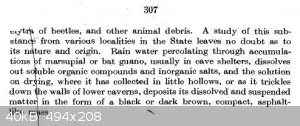 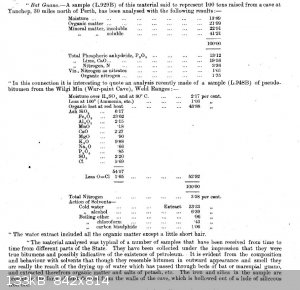
[Edited on 1-6-2018 by barbs09]
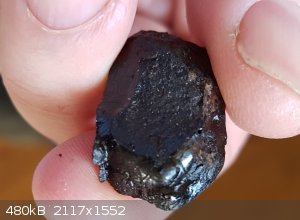
|
|
|
aga
Forum Drunkard
    
Posts: 7030
Registered: 25-3-2014
Member Is Offline
|
|
Fascinating find barbs09.
Edit:
I assumed it would burn. Odd.
Try heating it and see how the stuff separates.
If you're without a lab, stick a lump on at the edge of an upside-down frying pan, stick that bit near a fire and see what oil rolls off and what is
left behind.
[Edited on 1-6-2018 by aga]
|
|
|
Harristotle
Hazard to Others
  
Posts: 138
Registered: 30-10-2011
Location: Tinkerville
Member Is Offline
Mood: I tink therefore I am
|
|
You may also have come across an old Stick Nest rat nest (Leporillus conditor). They used to produce a gummy bituminous resin from their droppings,
and I remember finding these in the breakaways out from Cue in the Murchison, on holiday as a boy. They are now extinct on the mainland - slaughtered
by foxes.
Is there a lot of sandalwood or quandong around where you found these?
Cheers, H.
|
|
|
barbs09
Hazard to Others
  
Posts: 113
Registered: 22-1-2009
Location: Australia
Member Is Offline
Mood: No Mood
|
|
Its a small world
That's what I thought Aga, I will have a play around as you suggest, however given its solubility I don't think it is a hydrocarbon or tar or even a
resin. I suspect it is a very fine grained crystalline material that has slowly formed by the evaporation of rare soluble materials during alternate
rare rains and long dry periods.
Harristotle, I lived in Cue for 3 years and Mt Magnet for 5... (hence the subject title of my post).
One photo is of a crack in the roof of "cave" in a breakaway showing how it likely forms in response to percolation of fluids. Alternately animals
may have used the cracks to live in. The landscape photo is from the mouth of the breakaway, more for Harristotle's benefit  . Its a bit north of Meeka. . Its a bit north of Meeka.
I have seen Sandlewoods around but not quandong's.
Cheers for the interest.
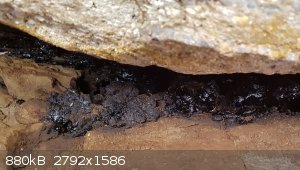 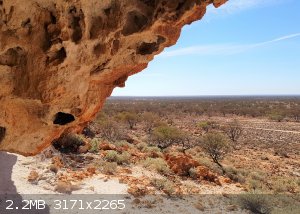
|
|
|
Harristotle
Hazard to Others
  
Posts: 138
Registered: 30-10-2011
Location: Tinkerville
Member Is Offline
Mood: I tink therefore I am
|
|
I think that this is what you are looking at:
https://www.flickr.com/photos/centralaustralia/8419934060
I think the origin of the gum/bitumen is the spinifex resin, post chewing!
Thanks for the memories - it is over 40 years since I last saw one of those nests. If you see an inhabitant, raise the alarm discretely. Many people
mourn the extinction of this beautiful, social and gentle animal.
PS: memory is not reliable - it is the lesser stick-nest rat Leporillus apicalis, not L. conditor, whose nest you would have found.
Cheers,
H.
|
|
|
barbs09
Hazard to Others
  
Posts: 113
Registered: 22-1-2009
Location: Australia
Member Is Offline
Mood: No Mood
|
|
Well it does look like the same material. Trouble is, the photo you linked to looks like a horizontal platform, where the rodent could obviously sit,
chew and poo, the picture I showed is of a narrow vertical crack well off the ground.
I reckon the only inhabitant i'd likely come across in those breakaways is a venomous snake!!
Thanks for the info 
[Edited on 4-6-2018 by barbs09]
|
|
|